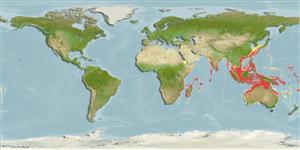Malacostraca |
Decapoda |
Alpheidae
Environment: milieu / climate zone / djupintervall / distribution range
Ekologi
Revassocierade; djupintervall 1 - 155 m (Ref. 69553). Tropical
Indo-West Pacific: Eastern Africa to Japan, Australia and Gilbert Islands.
Length at first maturity / Size / Weight / Age
Könsmognad: Lm ? range ? - ? cm
Minimum depth from Ref. 101096. Epizoic, subtidal on hard bottom (Ref. 106854). Found in dead coral heads and under rocks. Frequently associated with crinoids and occasionally with alcyonarians (Ref. 69553). Feeds on the mucus produced by feather stars and being a commensal, they also protect the feather star from its predators (Ref. 85383).
Life cycle and mating behavior
Könsmognad | Reproduktion | Lek | Eggs | Fecundity | Larvae
Members of the order Decapoda are mostly gonochoric. Mating behavior: Precopulatory courtship ritual is common (through olfactory and tactile cues); usually indirect sperm transfer.
Chace, F.A. Jr. 1988 The caridean shrimps (Crustacea--Decapoda) of the Albatross Philippine Expedition, 1907-1910. Part 5, Family Alpheidae. Smithson. Contr. Zool. (466):1- 99. (Ref. 69553)
IUCN Red List Status
(Ref. 130435: Version 2025-1)
CITES status (Ref. 108899)
Not Evaluated
Not Evaluated
Threat to humans
Harmless
Human uses
| FishSource |
Verktyg
Ytterligare information
Trophic EcologyFood items (preys)
Födosammansättning
Födointag
Predatorer
Population dynamicsTillväxt
Max. ages / sizes
Length-weight rel.
Length-length rel.
Length-frequencies
Mass conversion
Abundans
PhysiologySyreförbrukning
Human RelatedStamps, coins, misc.
Internet-källor
Estimates based on models
Preferred temperature
(Ref.
115969): 24.2 - 29, mean 27.9 (based on 1628 cells).
